Intel Fires Up Xeon Max CPUs, GPUs To Rival AMD, Nvidia
Intel reveals specifications of Xeon Max CPUs and Ponte Vecchio compute GPUs.
Just days before Supercomputing 22 kicks off, Intel introduced its next-generation Xeon Max CPU, previously codenamed Sapphire Rapids HBM, and Data Center GPU Max Series compute GPUs, known as Ponte Vecchio. The new products cater to different types of high-performance computing workloads or work together to solve the most complex supercomputing tasks.
The Xeon Max CPU: Sapphire Rapids Gets 64GB of HBM2E
General-purpose x86 processors have been used for virtually all kinds of technical computing for decades and therefore support many applications. However, while the performance of general-purpose CPU cores has scaled rather rapidly for years, today's processors have two significant limitations regarding performance in artificial intelligence and HPC workloads: parallelization and memory bandwidth. Intel's Xeon Max 'Sapphire Rapids HBM' processors promise to remove both boundaries.

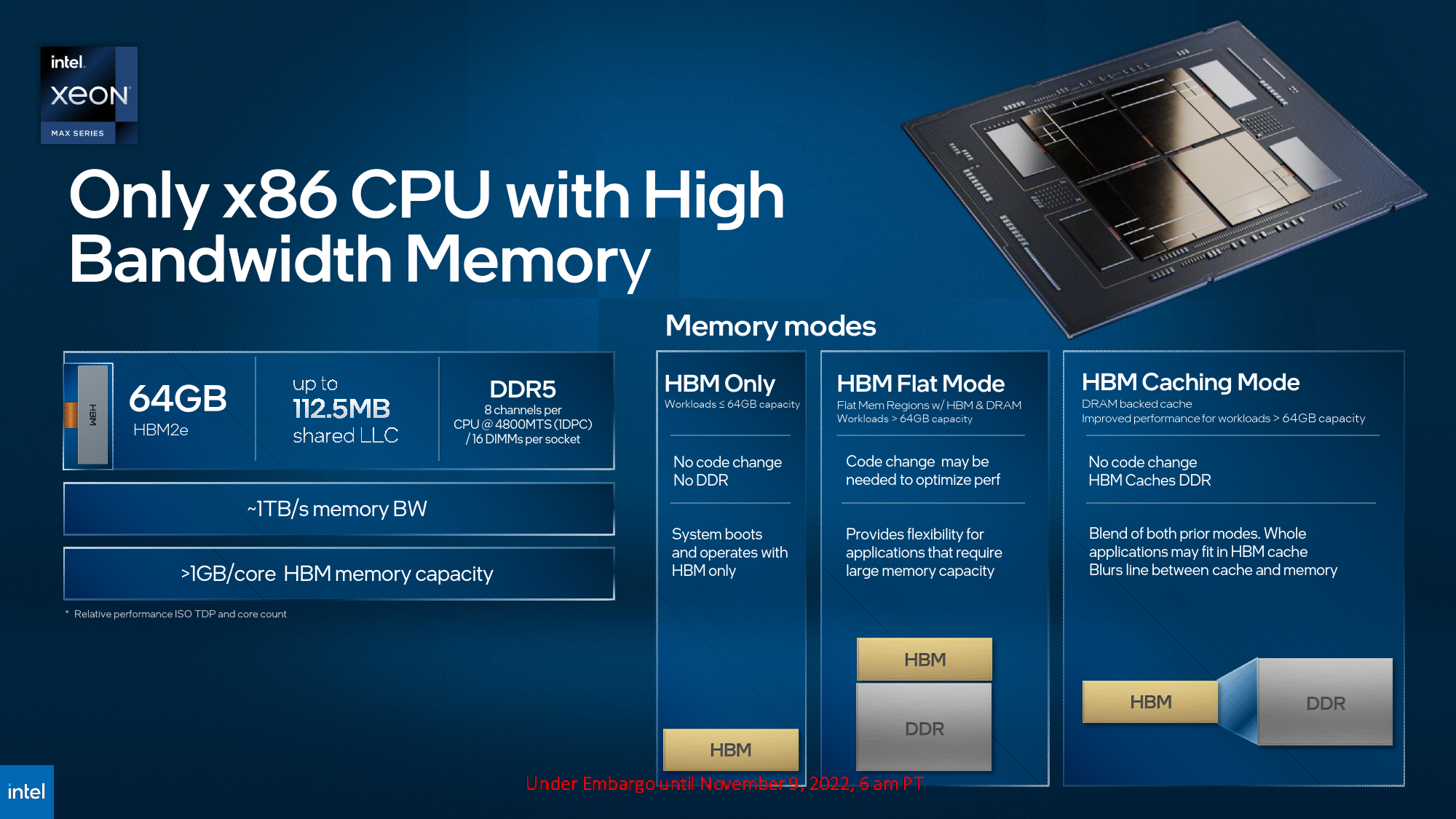

Intel's Xeon Max processor features up to 56 high-performance Golden Cove cores (spread over four chiplets interconnected using Intel's EMIB technology) further enhanced with multiple accelerator engines for AI and HPC workloads and 64GB of on-package HBM2E memory. Like other Sapphire Rapids CPUs, the Xeon Max will still support eight channels of DDR5 memory and PCIe Gen 5 interface with the CXL 1.1 protocol on top, so it will be able to all those CXL-enabled accelerators when it makes sense.
In addition to vector AVX-512 and Deep Learning Boost (AVX512_VNNI and AVX512_BF16) accelerators support, the new cores also bring Advanced Matrix Extensions (AMX) tiled matrix multiplication accelerator, which is essentially a grid of fused multiply-add units supporting BF16 and INT8 input types that can be programmed using only 12 instructions and perform up to 1024 TMUL BF16 or 2048 TMUL INT8 operations per cycle per core. Also, the new CPU supports Data Streaming Accelerator (DSA), which offloads data copy and transformation workloads from the CPU.
64GB of on-package HBM2E memory (four stacks of 16GB) provides a peak bandwidth of around 1TB/s, which translates to ~1.14GB of HBM2E per core at 18.28 GB/s per core. To put the numbers into context, a 56-core Sapphire Rapids processor equipped with eight DDR5-4800 modules gets up to 307.2 GB/s of bandwidth, which means 5.485 GB/s per core. Meanwhile, Xeon Max can use its HBM2E memory in different ways: use it as system memory, which requires no code change; use it as a high-performance cache for DDR5 memory subsystem, which does not require change code; use it as a part of a unified memory pool (HBM flat mode), which involves software optimizations.
Depending on the workload, Intel's AMX-enabled Xeon Max processor can provide a 3X – 5.3X performance improvement over the currently available Xeon Scalable 8380 processor that uses conventional FP32 processing for the same workloads. Meanwhile, in applications like model development for molecular dynamics, the new HBM2E-equipped CPUs are up to 2.8X times faster than AMD's EPYC 7773X, which features 3D V-Cache.











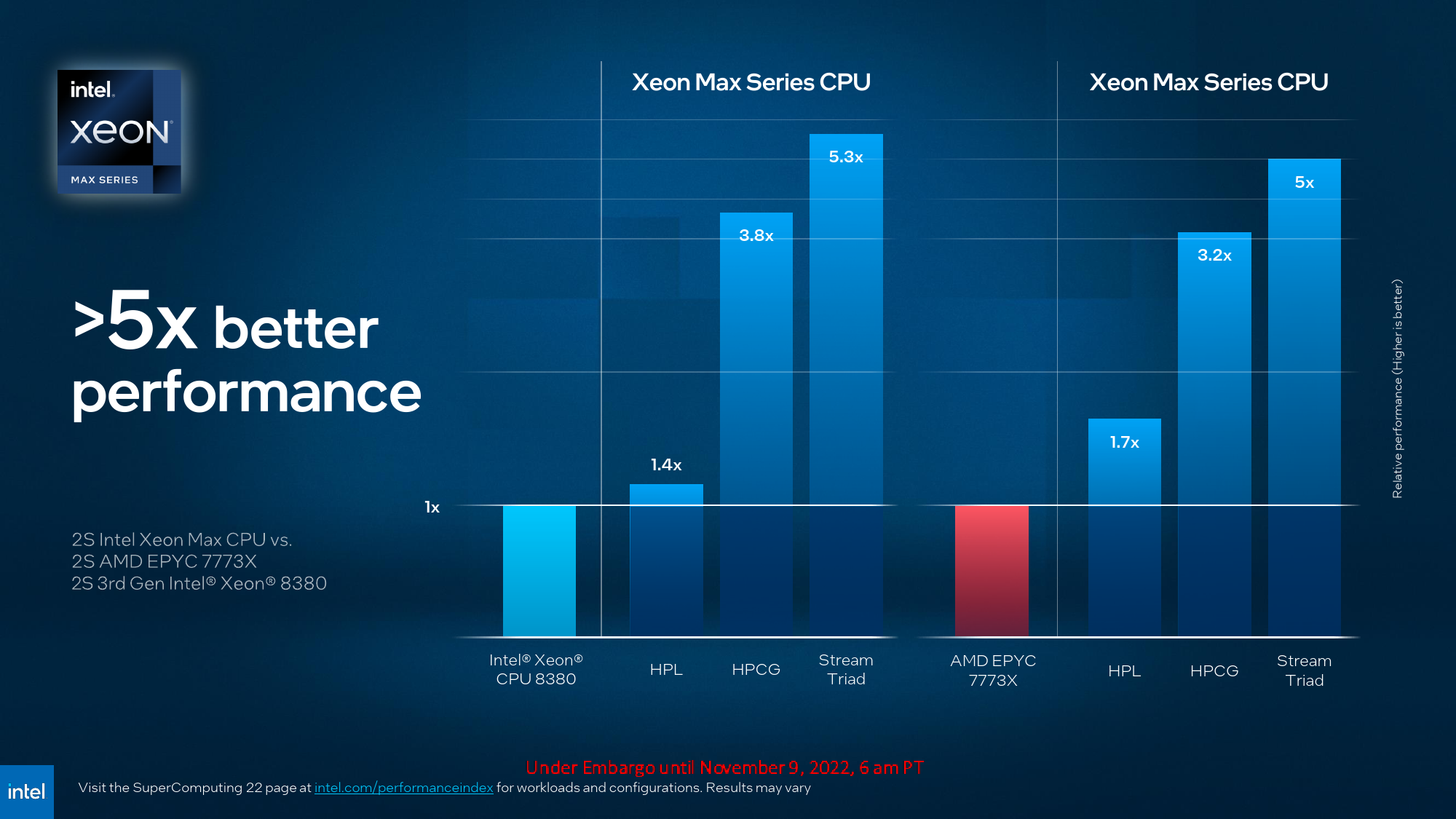

But HBM2E has another important implication for Intel as it somewhat reduces data movement overhead between CPU and GPU, which is essential for various HPC workloads. It brings us to the second of today's announcements: the Data Center GPU Max Series compute GPUs.
Get Tom's Hardware's best news and in-depth reviews, straight to your inbox.
The Data Center GPU Max: The Pinnacle of Intel's Datacenter Innovations
Intel's Data Center GPU Max compute GPU series will employ the company's codenamed Ponte Vecchio architecture, first introduced in 2019 and then detailed in 2020 ~ 2021. Intel's Ponte Vecchio is the most complex processor ever created, as it packs over 100 billion transistors (not including memory) over 47 tiles (including 8 HBM2E tiles). In addition, the product extensively uses Intel's advanced packaging technologies (e.g., EMIB) as different tiles are made by other manufacturers using different process technologies.




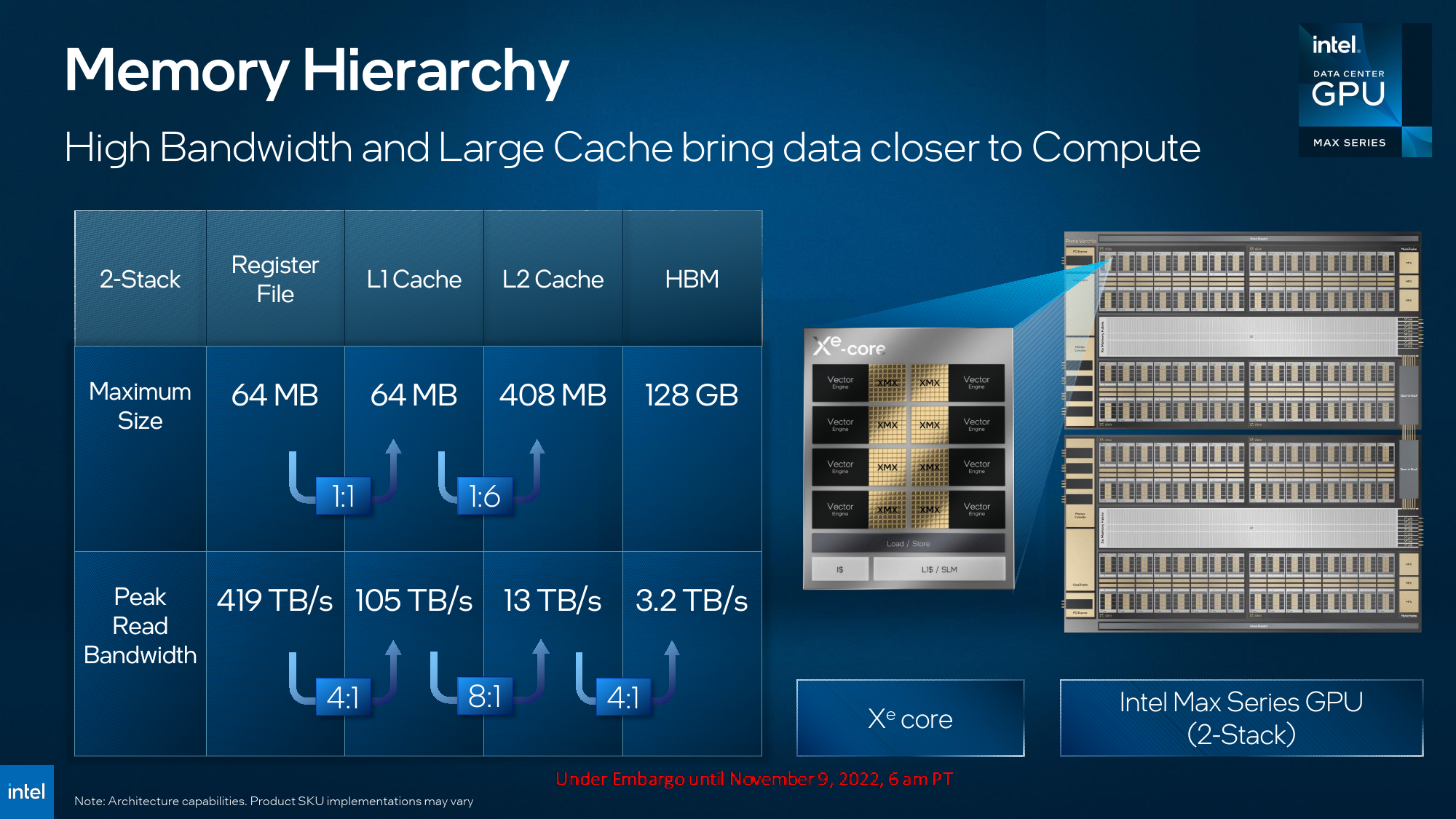

Intel's Data Center GPU Max compute GPUs will rely on the company's Xe-HPC architecture tailored explicitly for AI and HPC workloads and therefore support appropriate data formats and instructions as well as 512-bit vector and 4096-bit matrix (tensor) engines.
| Header Cell - Column 0 | Data Center Max 1100 | Data Center Max 1350 | Data Center Max 1550 | AMD Instinct MI250X | Nvidia H100 | Nvidia H100 | Rialto Bridge |
|---|---|---|---|---|---|---|---|
| Form-Factor | PCIe | OAM | OAM | OAM | SXM | PCIe | OAM |
| Tiles + Memory | ? | ? | 39+8 | 2+8 | 1+6 | 1+6 | many |
| Transistors | ? | ? | 100 billion | 58 billion | 80 billion | 80 billion | loads of them |
| Xe HPC Cores | Compute Units | 56 | 112 | 128 | 220 | 132 | 114 | 160 Enhanced Xe HPC Cores |
| RT Cores | 56 | 112 | 128 | - | - | - | ? |
| 512-bit Vector Engines | 448 | 896 | 1024 | ? | ? | ? | ? |
| 4096-bit Matrix Engines | 448 | 896 | 1024 | ? | ? | ? | ? |
| L1 Cache | ? | ? | 64MB at 105 TB/s | ? | ? | ? | ? |
| L2 Rambo Cache | ? | ? | 408MB at 13 TB/s | ? | 50MB | 50MB | ? |
| HBM2E | 48GB | 96GB | 128GB at 3.2 TB/s | 128 GB/s at 3.2 TB/s | 80GB at 3.35 TB/s | 8GB at 2 TB/s | ? |
| Multi-GPU IO | 8 | 16 | 16 | 8 | 8 | 8 | ? |
| Power | 300W | 450W | 600W | 560W | 700W | 350W | 800W |
Compared to Xe-HPG, Xe-HPC has considerably more sophisticated memory and caching subsystems, differently configured Xe cores (each Xe-HPG core features 16 256-bit vector and 16 1024-bit matrix engines, whereas each Xe-HPC core sports eight 512-bit vector and eight 4096-bit vector engines). Furthermore, Xe-HPC GPUs do not feature texturing units or render back ends, so they cannot render graphics using traditional methods. Meanwhile, Xe-HPG surprisingly supports ray tracing for supercomputer visualization.
One of the most important ingredients of Xe-HPC is Intel's Xe Matrix Extensions (XMX) that enable rather formidable tensor/matrix performance of Intel's Data Center GPU Max 1550 (see the table below) — up to 419 TF32 TFLOPS and up to 1678 INT8 TOPS, according to Intel. Of course, peak performance numbers provided by compute GPU developers are important but may not reflect performance achievable on real-world supercomputers in real-world applications. Still, we cannot help but notice that Intel's range-topping Ponte Vecchio is significantly behind Nvidia's H100 in most cases and fails to deliver tangible advantages over AMD's Instinct MI250X across all cases except FP32 Tensor (TF32).
| Header Cell - Column 0 | Data Center Max 1550 | AMD Instinct MI250X | Nvidia H100 | Nvidia H100 |
|---|---|---|---|---|
| Form-Factor | OAM | OAM | SXM | PCIe |
| HBM2E | 128GB at 3.2 TB/s | 128 GB/s at 3.2 TB/s | 80GB at 3.35 TB/s | 80GB at 2 TB/s |
| Power | 600W | 560W | 700W | 350W |
| Peak INT8 Vector | ? | 383 TOPS | 133.8 TFLOPS | 102.4 TFLOPS |
| Peak FP16 Vector | 104 TFLOPS | 383 TFLOPS | 134 TFLOPS | 102.4 TFLOPS |
| Peak BF16 Vector | ? | 383 TFLOPS | 133.8 TFLOPS | 102.4 TFLOPS |
| Peak FP32 Vector | 52 TFLOPS | 47.9 TFLOPS | 67 TFLOPS | 51 TFLOPS |
| Peak FP64 Vector | 52 TFLOPS | 47.9 TFLOPS | 34 TFLOPS | 26 TFLOPS |
| Peak INT8 Tensor | 1678 TOPS | ? | 1979 TOPS | 3958 TOPS* | 1513 TOPS | 3026 TOPS* |
| Peak FP16 Tensor | 839 TFLOPS | ? | 989 TFLOPS | 1979 TFLOPS* | 756 TFLOPS | 1513 TFLOPS* |
| Peak BF16 Tensor | 839 TFLOPS | ? | 989 TFLOPS | 1979 TFLOPS* | 756 TFLOPS | 1513 TFLOPS* |
| Peak FP32 Tensor | 419 TFLOPS | 95.7 TFLOPS | 989 TFLOPS | 756 TFLOPS |
| Peak FP64 Tensor | - | 95.7 TFLOPS | 67 TFLOPS | 51 TFLOPS |
Meanwhile, Intel says that its Data Center GPU Max 1550 is 2.4x faster than Nvidia's A100 on Riskfuel credit option pricing and offers a 1.5x performance improvement over A100 for NekRS virtual reactor simulations.
Intel plans to offer three Ponte Vecchio products: the top-of-the-range Data Center GPU Max 1550 in OAM form-factor featuring 128 Xe-HPC cores, 128GB of HBM2E memory, and rated for up to 600W thermal design power; the cut-down Data Center GPU Max 1350 in OAM form-factor with 112 Xe-HPC cores, 96GB of memory, and a 450W TDP; and the entry-level Data Center GPU Max 1100 that comes in a dual-wide FLFH form-factor and carries a processor with 56 Xe-HPC cores, has 56GB of HBM2E memory and rated for a 300W TDP.
Meanwhile, to its supercomputer clients, Intel will offer Max Series Subsystems with four OAM modules on a carrier board rated for a 1,800W and 2,400W TDP.






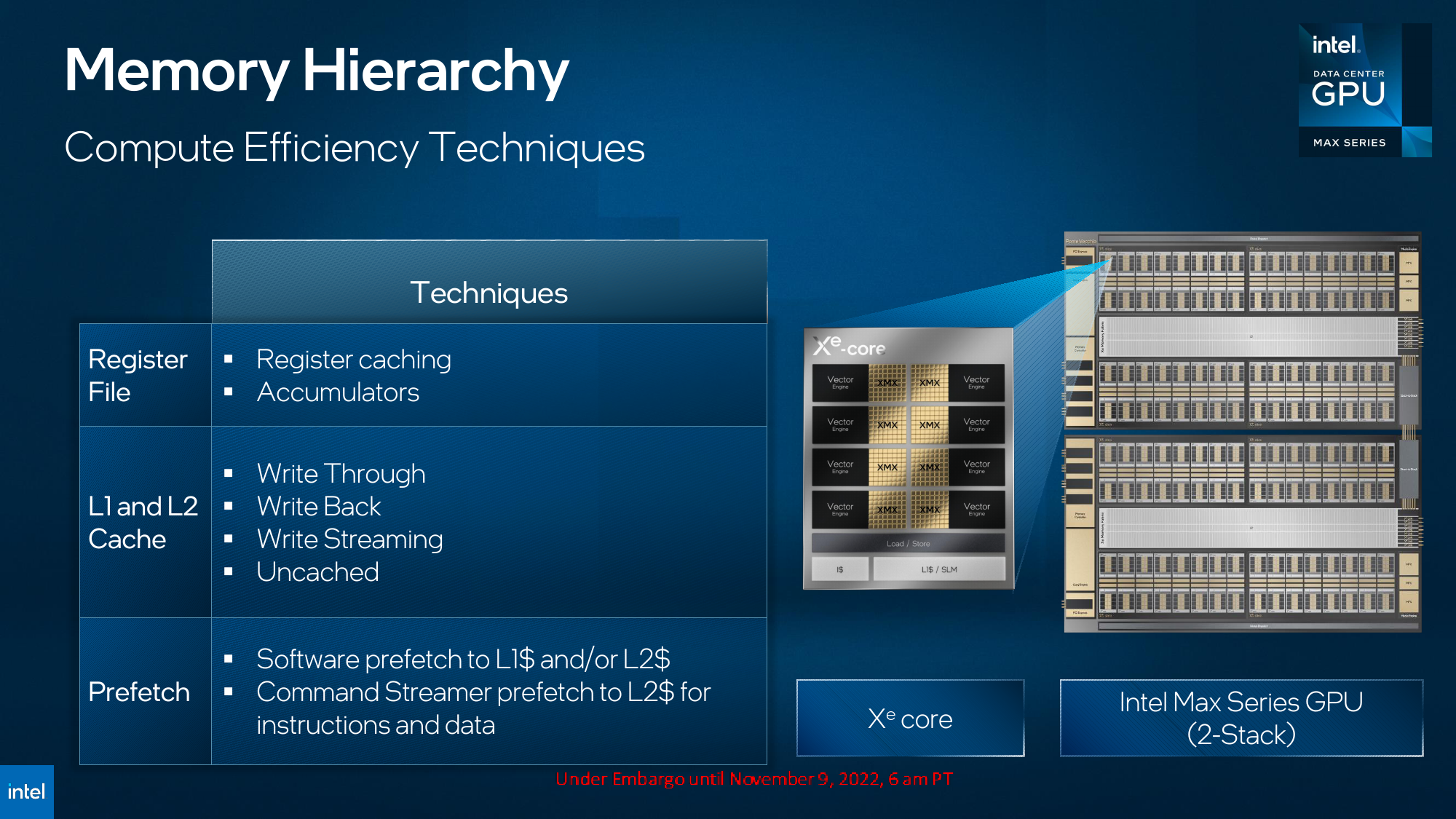






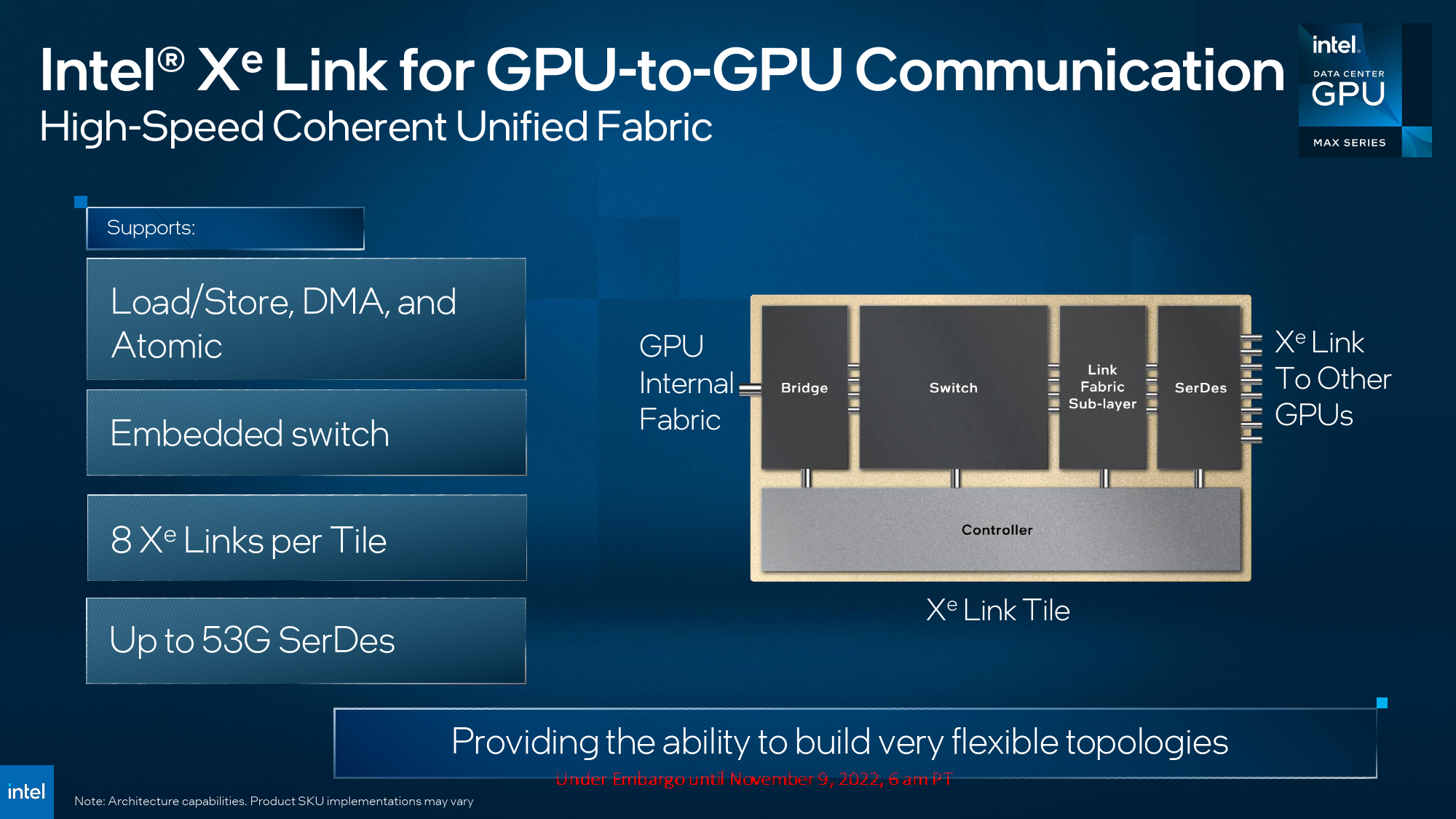
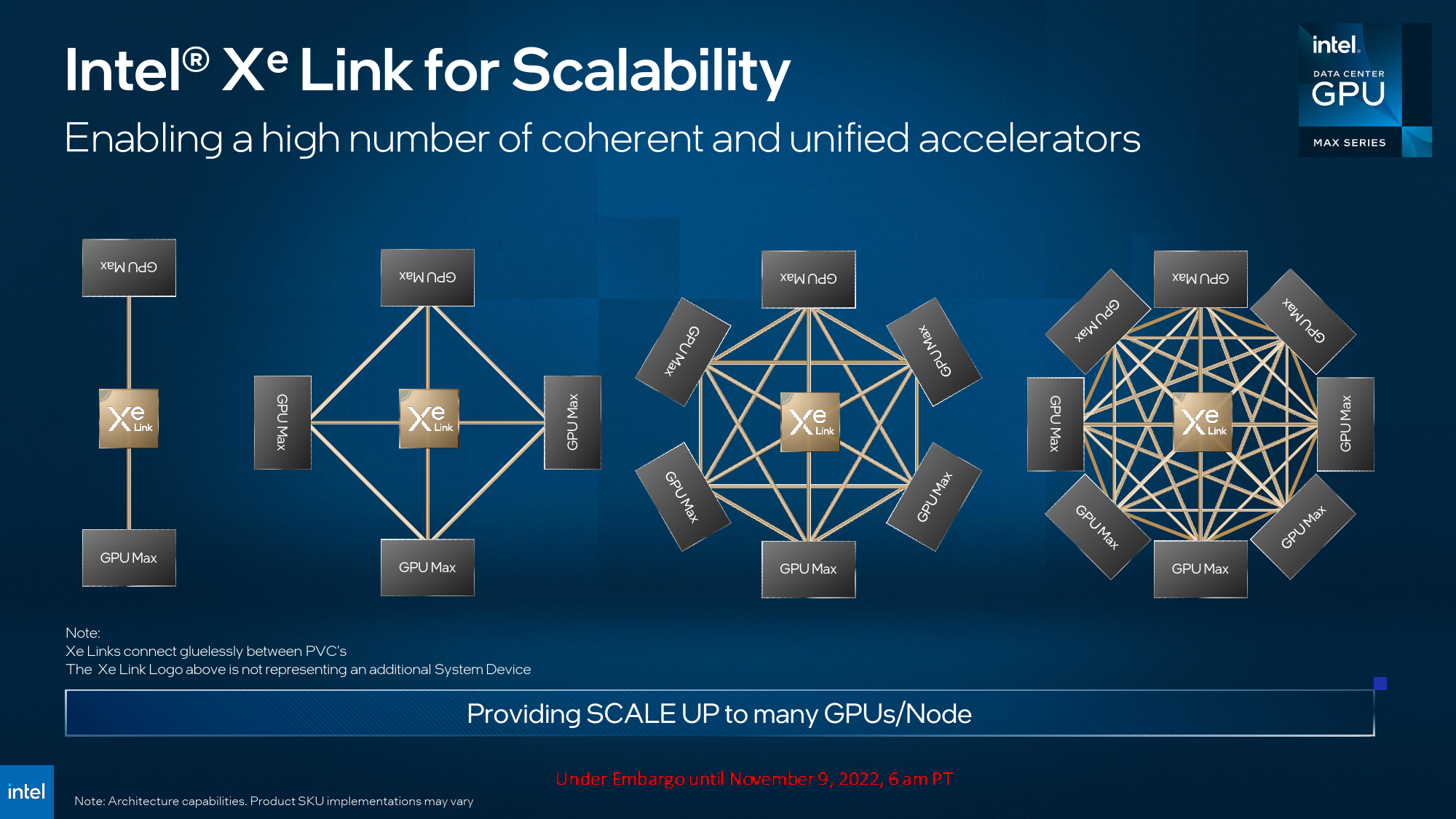
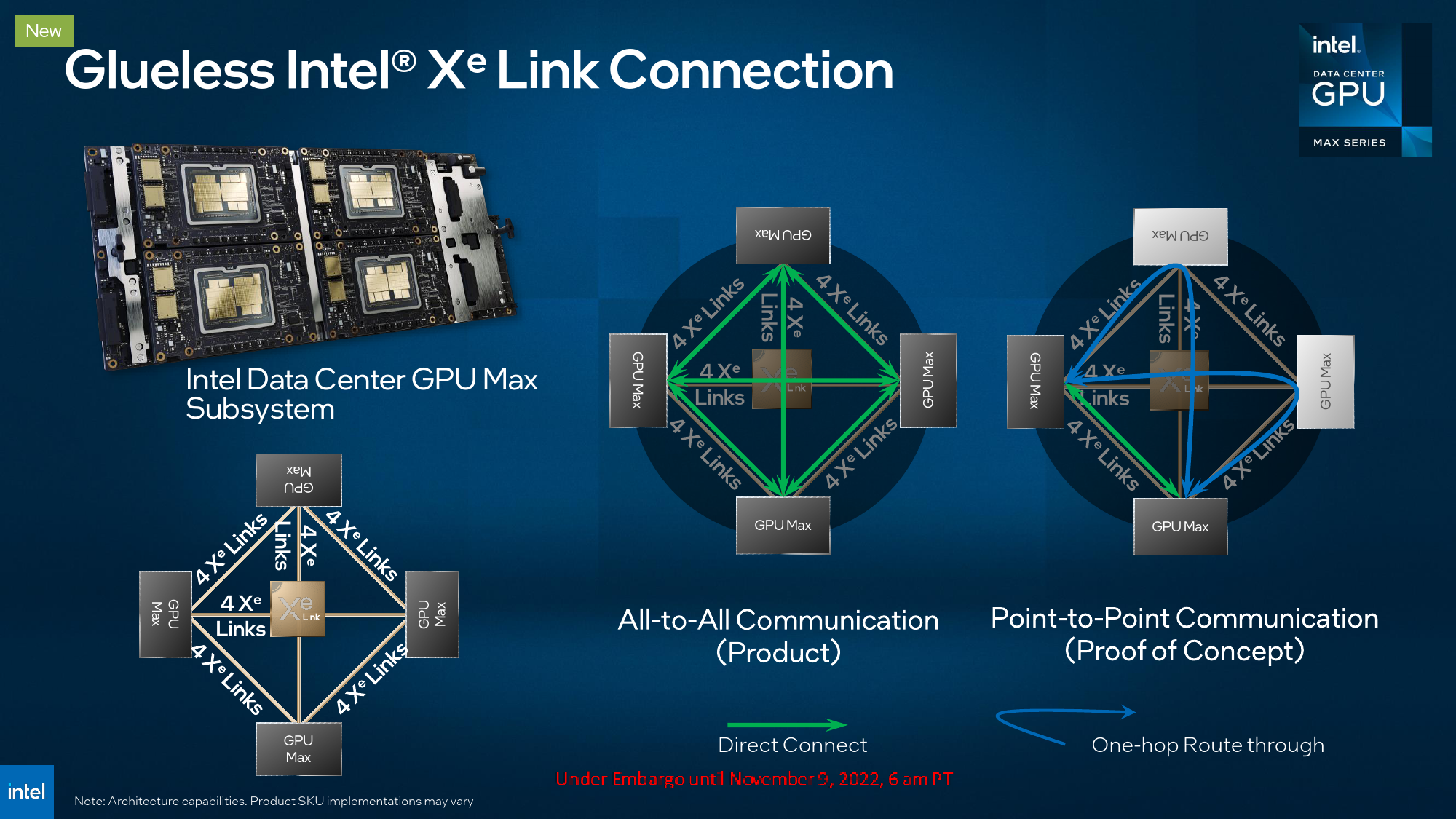

Intel's Rialto Bridge: Enhancing the Max
In addition to formally unveiling its Data Center GPU Max compute GPUs, Intel today also gave a sneak peek at its next-generation Data Center GPU, codenamed Rialto Bridge which arrives in 2024. This AI and HPC compute GPU will be based on enhanced Xe-HPC cores, presumably with a slightly different architecture, but will maintain compatibility with Ponte Vecchi-based applications. Unfortunately, that additional complexity will increase the TDP of the next-generation flagship compute GPU to 800W, though there will be simpler and less power-hungry versions.
Availability
One of the first customers to get both Intel Xeon Max and Intel Data Center GPU Max products will be Argonne National Laboratory, which is building its >2 ExaFLOPS supercomputers based on over 10,000 blades using Xeon Max CPUs and Data Center GPU Max devices (two CPUs and six GPUs per blade). In addition, Intel and Argonne are finishing building Sunspot, Aurora's test development system consisting of 128 production blades that will be available to interested parties in late 2022. The Aurora supercomputer should come online in 2023.
Intel's partners, among server makers, will launch machines based on Xeon Max CPUs and Data Center GPU Max devices in January 2023.

Anton Shilov is a contributing writer at Tom’s Hardware. Over the past couple of decades, he has covered everything from CPUs and GPUs to supercomputers and from modern process technologies and latest fab tools to high-tech industry trends.
-
TerryLaze Reply
Yeah, 64Gb of onboard HBME that can work as both system ram or cache for real ram, no wonder they shut down optane.lorfa said:HBM as system memory, fascinating
I wonder how long it's going to take for it to become cheap enough to end up in the normal desktop lineup in 4 or 8Gb versions. Not only would you have the performance of 3dVcache but you could use the CPU without any actual ddr ram making it much cheaper. (Or maybe it will just balance out the cost of the HBM) -
bit_user Reply
FWIW, I thought it would happen years ago. And I actually guessed AMD would be first, since they already had experience with HBM, in their Fury and Vega GPUs.lorfa said:HBM as system memory, fascinating
That said, Intel did launch Xeon Phi (KNL) with 16 GB of in-package McDRAM, back in 2016. And it could even slot into a normal sever CPU socket and use the DDR4 DIMMs as well. So, this isn't even their first go at a CPU with in-package memory.
...and then there's Lakefield, but probably the less said about that, the better.
; )
No, they shut down Optane because it offered no benefits over battery-backed DRAM. Even cost-wise, it just couldn't keep ahead.TerryLaze said:no wonder they shut down optane.
Assuming it had maintained a cost advantage over DRAM, what I was expecting to see was Optane essentially being used as "swap space", so you could scale up capacity of these HBM-equipped servers into the many TBs. Instead, it looks like they'll have to make due with conventional DRAM DIMMs, and any nonvolatile storage will probably live out on the CXL bus. Eventually, I think direct-connected memory might get entirely replaced by CXL, so you have just that + whatever is in-package.
Uh, like 2 years ago, when Apple launched the M1. Okay, that was LPDDR4, but it was still stacks of DRAM in-package. The M1 Max then showed how you can scale performance, by upgrading it to LPDDR5 and widening the memory bus to 256-bit.lorfa said:I wonder how long it's going to take for it to become cheap enough to end up in the normal desktop lineup in 4 or 8Gb versions.
I wonder how much cost-savings there is. Certainly, the motherboard gets cheaper, because you don't have DIMM slots and you can reduce the number of contacts in the socket (not to mention the traces connecting them). You'd save money on the DIMMs, but the actual DRAM dies still cost the same, and what you save on the physical DIMM might simply offset the added packaging costs of integrating the DRAM stacks.lorfa said:you could use the CPU without any actual ddr ram making it much cheaper.
The obvious downside is that if one of your DRAM dies eats it, you have to trash the whole package and get a replacement. If it's BGA, say goodbye to the entire motherboard, also. Yay, disposable tech!
That said, if it's just isolated errors, you can exclude those pages from use. And DDR5 has internal ECC, which could potentially make it more reliable, depending on how much they provision. -
TerryLaze Reply
Are you talking about the DIMMs?bit_user said:No, they shut down Optane because it offered no benefits over battery-backed DRAM. Even cost-wise, it just couldn't keep ahead.
Assuming it had maintained a cost advantage over DRAM,
Because according to articles optane DIMMs even though very expensive were extremely cheap compared to normal DRAM, and maybe even more important you could get amounts of ram that would just be impossible to reach with only normal ram.
Less than $1000 compared to well over $4000 is a huge difference.
https://www.tomshardware.com/news/intel-optane-dimm-pricing-performance,39007.html
128GB Optane DIMM256GB Optane DIMM512GB Optane DIMMIntel System Pricing Guidance$577$2,125$6,751CompSource$892$2,850-ShopBLT$842$2,668$7,816Colfax Direct$695$2,595$8,250Conventional DRAM~$4,500Not AvailableNot Available -
bit_user Reply
I'm talking about DRAM. Instead of having an Optane U.2 drive, you could have a U.2 drive full of DDR4 + a NVMe controller and a battery, for instance.TerryLaze said:Are you talking about the DIMMs?
The price I'm seeing for 64 GB DDR4 DIMMs is something like $3.45 per GB, whereas if we look at the Optane P5800X 1.6 TB, it's $2.36 per GB. Still better, but definitely uncomfortably close, especially when you consider that DDR4 is even faster and has even higher write-endurance. I'm guessing someone at Intel worked out the trend lines and found they cross in the not-too-distantant future.
That said, I don't know what's going on with that Optane DIMM pricing, because that's already noncompetitive, on a raw per-GB basis, with DDR4. And when I go to Newegg and look at pricing of 128 GB server DIMMs, I see SK Hynix memory for $1500 per DIMM. BTW, that's still DDR4 as Newegg hasn't started selling DDR5 server memory.
However, I think it's a mistake to limit this to DIMMs, because CXL is going to throw the doors wide open to various form factors. -
samopa Replybit_user said:The obvious downside is that if one of your DRAM dies eats it, you have to trash the whole package and get a replacement. If it's BGA, say goodbye to the entire motherboard, also. Yay, disposable tech!
That's the reason Apple implemented it in their devices ;) -
samopa Replybit_user said:...and then there's Lakefield, but probably the less said about that, the better.
What is Lakefield ?
I have no collection of memory about that, I'm too old to remember that ... -
bit_user Reply
It was actually a pretty bold product by Intel, considering how many technologies it pioneered (hybrid cores, die-stacking, and in-package memory). It just didn't have stellar market success, perhaps partly falling victim to poor support for hybrid CPUs in Windows, as well as the decision to disable AVX/AVX2 in the P-core due to the E-cores lacking it. I think it also suffered from being positioned as a premium product, yet it probably lacked the performance of one.samopa said:What is Lakefield ?
I have no collection of memory about that, I'm too old to remember that ...
https://www.tomshardware.com/news/intel-lakefield-foveros-3d-chip-stack-hybrid-processor,40205.htmlhttps://www.notebookcheck.net/Intel-and-LEGO-team-up-to-help-visualize-what-makes-Lakefield-so-special.470160.0.htmlhttps://www.tomshardware.com/news/intel-lakefield-cpu-specshttps://www.tomshardware.com/news/intels-first-3d-processors-lakefield-up-close-and-personal-in-the-lenovo-x1-fold-teardownhttps://www.tomshardware.com/news/intel-lakefield-cpu-benchmarks-show-promising-performancehttps://www.tomshardware.com/news/intel-retires-lakefield
One bright point about Lakefield is that it had probably the coolest promo gimmick of any CPU I've ever heard of:
I bet those lego kits would probably fetch a pretty penny among CPU collectors. -
jeremyj_83 Reply
That is from 2019. I can tell you from pricing out servers with Optane or just DRAM that in 2021/22 the difference in price for 128GB Optane was only 1/2 that of actual DIMMs. Throw in all the other issues using Optane Memory and it just wasn't worth while for companies to use. In order to use non-volatile nature of Optane you had to have software that was aware of it for App Direct Mode. Otherwise you could only use it in Memory Mode so it lost the non-volatility and for best performance you needed a 1:4 ratio RAM:Optane. At that point it was basically the same price to use 12x 64GB DIMMs vs 6x 32GB + 6x 128GB Optane.TerryLaze said:Are you talking about the DIMMs?
Because according to articles optane DIMMs even though very expensive were extremely cheap compared to normal DRAM, and maybe even more important you could get amounts of ram that would just be impossible to reach with only normal ram.
Less than $1000 compared to well over $4000 is a huge difference.
https://www.tomshardware.com/news/intel-optane-dimm-pricing-performance,39007.html
128GB Optane DIMM256GB Optane DIMM512GB Optane DIMMIntel System Pricing Guidance$577$2,125$6,751CompSource$892$2,850-ShopBLT$842$2,668$7,816Colfax Direct$695$2,595$8,250Conventional DRAM~$4,500Not AvailableNot Available